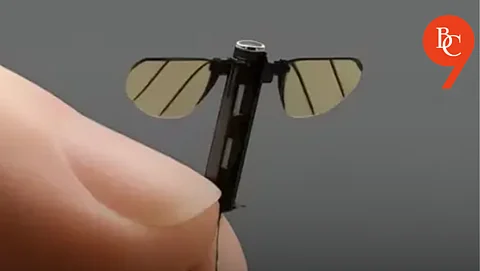

China has taken a giant leap in micro-robotics and military technology by unveiling a spy drone no larger than a mosquito measuring just 0.6 centimeters in length designed for stealth surveillance and intelligence-gathering operations. Developed by the National University of Defense Technology (NUDT) in Hunan province, this ultra-miniature drone mimics the appearance and flight of a mosquito, equipped with cutting-edge sensors, cameras, and microphones for covert reconnaissance.
The drone’s design is biomimetic, featuring two delicate leaf-shaped wings, a slender black body, and three hair-thin legs that replicate the anatomy of a real mosquito. This micro UAV is capable of flying silently and almost invisibly, making it extremely difficult to detect by both the naked eye and conventional radar systems.
In a demonstration broadcast on China Central Television’s military channel CCTV 7, NUDT student Liang Hexiang showcased the drone, saying, “Here in my hand is a mosquito-like type of robot. Miniature bionic robots like this one are especially suited to information reconnaissance and special missions on the battlefield.” The drone is controlled remotely, reportedly even via smartphone, emphasizing its operational flexibility.
Despite its minuscule size, the drone carries a suite of miniaturized equipment including ultra-compact cameras and microphones capable of capturing high-resolution images, audio, and electronic signals. Its stealthy profile allows it to infiltrate high-security or confined environments where traditional drones cannot operate effectively.
The drone is designed primarily for military intelligence, surveillance, and reconnaissance (ISR) missions, particularly in urban or indoor settings. Its ability to gather sensitive information discreetly poses new challenges for security and counterintelligence agencies worldwide.
While the drone’s operational range and endurance may be limited by its tiny power source, its suitability for precision espionage in sensitive areas makes it a formidable tool. The technology also raises ethical and legal questions about surveillance, privacy, and the potential misuse by state and non-state actors.
Notably, China recently revealed conceptual designs for a massive drone mothership capable of launching swarms of over 100 drones, indicating a multi-layered approach to future warfare and intelligence gathering.
China’s mosquito-like spy drone represents a paradigm shift in surveillance technology, blending biology and engineering to create near-invisible reconnaissance tools. While the device’s battlefield impact remains to be seen, its potential to redefine covert operations is undeniable.
